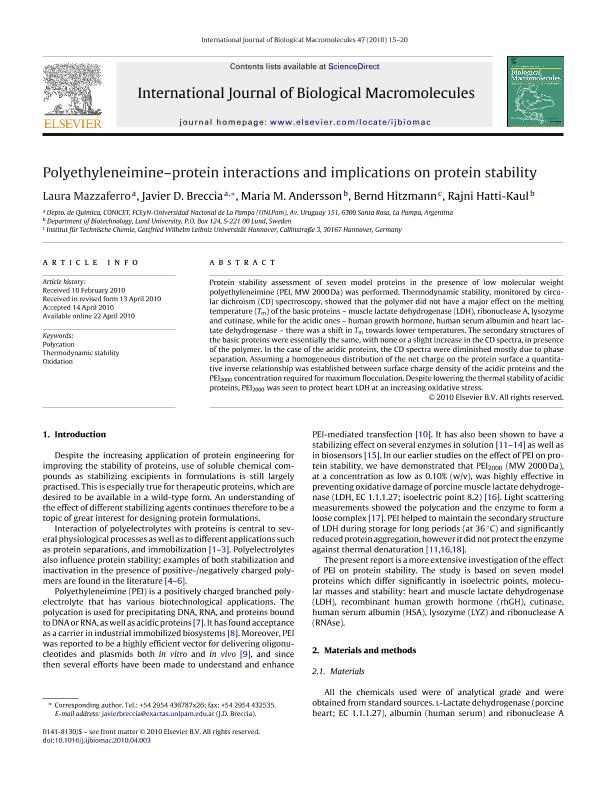Mostrar el registro sencillo del ítem
dc.contributor.author
Mazzaferro, Laura

dc.contributor.author
Breccia, Javier Dario

dc.contributor.author
Andersson, Maria M.
dc.contributor.author
Hitzmann, Bernd
dc.contributor.author
Hatti Kaul, Rajni
dc.date.available
2019-08-14T14:21:58Z
dc.date.issued
2010-07
dc.identifier.citation
Mazzaferro, Laura; Breccia, Javier Dario; Andersson, Maria M.; Hitzmann, Bernd; Hatti Kaul, Rajni; Polyethyleneimine-protein interactions and implications on protein stability; Elsevier Science; International Journal of Biological Macromolecules; 47; 1; 7-2010; 15-20
dc.identifier.issn
0141-8130
dc.identifier.uri
http://hdl.handle.net/11336/81594
dc.description.abstract
Protein stability assessment of seven model proteins in the presence of low molecular weight polyethyleneimine (PEI, MW 2000Da) was performed. Thermodynamic stability, monitored by circular dichroism (CD) spectroscopy, showed that the polymer did not have a major effect on the melting temperature (T m ) of the basic proteins - muscle lactate dehydrogenase (LDH), ribonuclease A, lysozyme and cutinase, while for the acidic ones - human growth hormone, human serum albumin and heart lactate dehydrogenase - there was a shift in T m towards lower temperatures. The secondary structures of the basic proteins were essentially the same, with none or a slight increase in the CD spectra, in presence of the polymer. In the case of the acidic proteins, the CD spectra were diminished mostly due to phase separation. Assuming a homogeneous distribution of the net charge on the protein surface a quantitative inverse relationship was established between surface charge density of the acidic proteins and the PEI 2000 concentration required for maximum flocculation. Despite lowering the thermal stability of acidic proteins, PEI 2000 was seen to protect heart LDH at an increasing oxidative stress.
dc.format
application/pdf
dc.language.iso
eng
dc.publisher
Elsevier Science

dc.rights
info:eu-repo/semantics/openAccess
dc.rights.uri
https://creativecommons.org/licenses/by-nc-sa/2.5/ar/
dc.subject
Oxidation
dc.subject
Polycation
dc.subject
Thermodynamic Stability
dc.subject.classification
Físico-Química, Ciencia de los Polímeros, Electroquímica

dc.subject.classification
Ciencias Químicas

dc.subject.classification
CIENCIAS NATURALES Y EXACTAS

dc.title
Polyethyleneimine-protein interactions and implications on protein stability
dc.type
info:eu-repo/semantics/article
dc.type
info:ar-repo/semantics/artículo
dc.type
info:eu-repo/semantics/publishedVersion
dc.date.updated
2019-08-13T19:16:14Z
dc.journal.volume
47
dc.journal.number
1
dc.journal.pagination
15-20
dc.journal.pais
Países Bajos

dc.journal.ciudad
Amsterdam
dc.description.fil
Fil: Mazzaferro, Laura. Consejo Nacional de Investigaciones Científicas y Técnicas; Argentina. Universidad Nacional de La Pampa. Facultad de Ciencias Exactas y Naturales. Departamento de Química; Argentina
dc.description.fil
Fil: Breccia, Javier Dario. Consejo Nacional de Investigaciones Científicas y Técnicas; Argentina. Universidad Nacional de La Pampa. Facultad de Ciencias Exactas y Naturales. Departamento de Química; Argentina
dc.description.fil
Fil: Andersson, Maria M.. Lund University; Suecia
dc.description.fil
Fil: Hitzmann, Bernd. Universität Hannover; Alemania
dc.description.fil
Fil: Hatti Kaul, Rajni. Lund University; Suecia
dc.journal.title
International Journal of Biological Macromolecules

dc.relation.alternativeid
info:eu-repo/semantics/altIdentifier/url/https://www.sciencedirect.com/science/article/pii/S0141813010001212
dc.relation.alternativeid
info:eu-repo/semantics/altIdentifier/doi/https://doi.org/10.1016/j.ijbiomac.2010.04.003
Archivos asociados
